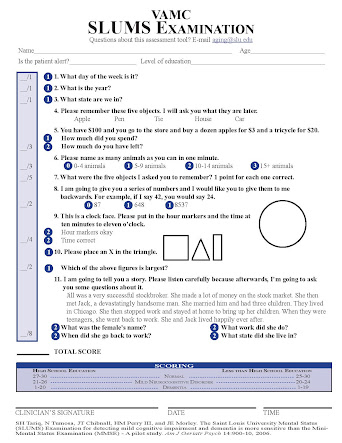SLUMS Cognitive Screening
Today in my Neuro Aspects course in Occupational Therapy school, I got the opportunity to administer a cognitive screening in a simulation with a client that had a recent history of a stroke. When explaining what cognition is to someone without medical experience or schooling, I would start by describing it as how our mind works – our thoughts, memory, personality and problem-solving all encased in one. If someone asked me about the role of an Occupational Therapist working with those with cognitive disorders, I would make sure to reiterate that our scope of practice is based heavily on the mental aspect of a human’s life. To follow that phrase, we work on trying to mend their cognition through therapeutic services or trying to adapt their routines, hobbies, jobs, and interests to accommodate to their mind set.
 |
| SLUMS Cognitive Screening (free online) |
When giving the screening, I was
not able to finish the last question due to the time restriction. However, from
my observations of the previous questions I was able to get through, it seems
like my client would possibly have a mild cognitive impairment. The biggest
indicator of this for me was the client was not able to draw a clock with the
time set to 10 minutes to 11. This client pushed all the numbers to the right side,
and this indicated to me that she has left neglect. Left neglect is a common
after effect of a client who has recently went through a R hemisphere CVA. The
types of challenges that a client with mild cognitive impairment may experience
are forgetfulness, impulsiveness, and a sense of being overwhelmed. They may
need some adaptations, cues, and changes in their routines to help the flow of
their day-to-day experiences and to prioritize their safety. At the beginning
of simulation, I explained to the client what Occupational Therapy is and I believe
that I explained in a way that she was able to understand and relate. I adapted
it by explained the overall purpose of our therapy, the population we work with
and what are things that we do in sessions to help them get back to what they
love. When I broke it down like this, I felt like she was able to understand
the full picture of what Occupational Therapists do.
I felt like I did a good job making
the client feel comfortable around me. I was trying to communicate with her
like a friend and I sat next to her, on her level, to establish rapport. If I
was given the opportunity to do this again, I would try to take the first 5
minutes to get to know the client better one on one. I think this would allow
me to understand her thought process, relate to her more, and make her feel
safe with me. My biggest takeaway from this process is that no matter how much
time we are restricted to with the screening, it is so important that we bring
a comforting demeanor and lighthearted persona because this will allow them to
feel much better around us, like they are cared for and heard. I have learned
that I need to continue to practice my soft skills with patients to feel more
confident about it when interacting.

Comments
Post a Comment